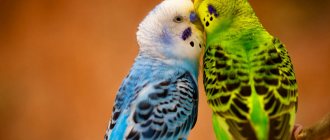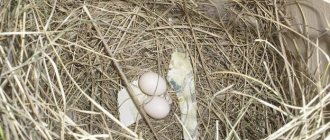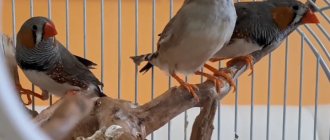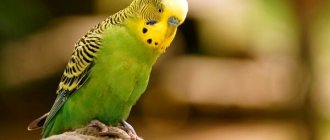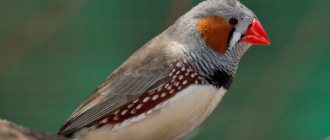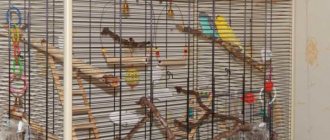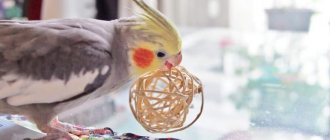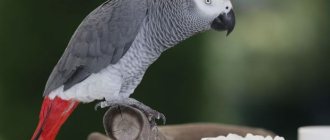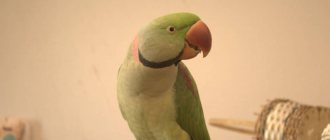Feeding is one of the most important aspects of keeping finches in captivity. The health, life expectancy and successful reproduction of birds depend on the chosen diet. Feeding finches with food that is of poor quality or that is toxic to them can lead to illness or even death of the pets. Feeding finches in captivity should take into account the nutritional needs of these birds. The diet is compiled based on data on the nutrition of finches in nature.
Grain mixtures
The main food for finches is grain mixtures. In nature, the largest portion of the diet of these birds consists of seeds and grains of cultivated and wild plants. This type of food provides birds with energy due to the large amount of carbohydrates it contains, and also acts as a source of vegetable protein, fiber, fats, vitamins, micro and macroelements. Grain mixtures for finches can be prepared independently or purchased ready-made at a pet store.
We assemble it ourselves
Grain mixtures for finches must include at least 6 types of products. The main component of the mixture is millet of various types. Finches eat white, gray and yellow most readily. Red millet should also be included in the bird's diet. It is rich in carotene and carotenoids, which are precursors of vitamin A, which is necessary for healthy eyes, mucous membranes and skin, as well as enhancing the color of feathers.
Peeled oats should be present in the amadin's diet. Birds usually eat it willingly, but in large quantities this food can cause intestinal blockage in them, as it contains a lot of fiber. Flaxseed is of great benefit to birds. It is rich in vegetable fats and fatty acids, which have a beneficial effect on the condition of the skin, feathers and overall health of the bird. Hemp seed also has the same properties, so it is also included in the grain mixture in small quantities. Mandatory components of the grain mixture for finches are also chumiza, rapeseed, mogar and canary seeds.
Finches love the seeds of meadow grasses: hedgehogs, timothy, fescue, shepherd's purse, plantain, etc. They are collected in the summer during the ripening period and dried, and then added to food throughout the year.
Seed collection must be carried out in environmentally friendly places - away from roads, large cities, industrial enterprises and farmland treated with pesticides.
To correctly compose a grain mixture for finches, you should take the following quantities of its components:
- millet – 1 kg;
- canary seeds – 300 g;
- meadow grass seeds – 250 g;
- oats – 150 g;
- chumizy – 100 g;
- rapeseed – 100 g;
- mogara – 100 g;
- flaxseed – 50 g;
- hemp seed – 50 g.
One finch needs 1-2 teaspoons of this grain mixture per day. Feeding birds more grains and seeds can cause them to become obese, which can be detrimental to their health. Depending on the species of finches, their diet can be diversified with additional types of grain feed. Thus, zebra finches love fresh corn and peas, and rice finches love peeled rice.
Purchased mixtures
Ready-made mixtures for feeding finches are widely available in pet stores. They can be sold by weight or in original packaging. Preference should be given to hermetically sealed boxes that indicate the expiration date. Weighed grain mixtures may contain low-quality or expired components.
Among the factory-made feed mixtures presented in pet stores, the products of foreign manufacturers are of the highest quality:
- Vitakraft;
- Padovan;
- Fiory.
Among the variety of products from these companies, it is necessary to choose food intended for exotic birds or specifically for finches; mixtures are not suitable for other types of birds.
Before feeding the purchased mixture, you need to make sure its quality. Good-quality food does not have a musty or rancid odor, traces of mold and pests, darkened grains, particles of debris and dust.
Features of behavior
But despite the unpretentiousness of finches in general, certain difficulties may well arise when maintaining them. It is necessary to know about them in order to be able to quickly take appropriate measures to solve problems. So, it will be very useful to describe them.
Reason for plucking a couple's feathers
Very often, having placed a couple in one cage and expecting that the birds will very soon begin building a nest and give birth, the breeder is puzzled by their behavior. Instead, they behave aggressively and even pluck each other's feathers. What is the reason for this behavior?
There may be several reasons for this. Firstly, there is not enough material to build a nest - the couple tries to make it softer, and in the absence of other fluff, they use their own. Secondly, this may indicate a lack of vitamins in the male’s body - at least if he not only plucks feathers, but also eats them. The problem can be solved by using mineral supplements as a top dressing.
Healthy! To prevent the birds from getting bored, it is worth hanging a mirror or a bell in the cage. They will keep birds occupied for a long time and distract them from aggression towards others.
Finally, the third case is the saddest. It's just a bad character in the bird. Yes, this also happens. The male gets bored and attacks the female, plucking her feathers. Nothing can be done about this - it is advisable to plant them. Such a male cannot be used for reproduction - there is a high probability that the habit will be passed on to the offspring.
Why do females and males fight?
It also happens that a couple of finches, instead of living in perfect harmony, organize real battles for survival - feathers fly in different directions. Moreover, this happens both before laying eggs and after several appear in the nest.
The situation is very unpleasant - the clutches will have to be sacrificed, and the birds will have to be placed in separate cages. After a few weeks, you can bring them together again and carefully monitor the reaction. If it happens again, then the couple is simply incompatible - you need to exchange the male for another, if possible. It is possible that in another pair he will show his best side.
Another variety is the Gouldian finch.
Note! However, this also happens in cases where a cage that is too small in size is used - the birds are cramped, which provokes them into conflict.
Can birds live alone?
Often people do not want to have a pair of finches or more: maybe the size of the cage does not allow or there is no desire to get offspring from birds. Therefore, the question arises: is it possible to have one bird?
In general, this is, of course, possible. But a lonely finch will definitely not be happy. On the one hand, simply because he does not have a company to play with. On the other hand, being alone is always a source of stress. In the wild, finches, like most small birds, always live in flocks. An individual that strays from it automatically becomes a victim of any bird of prey. Although there is no such danger in the cage, the birds feel constant discomfort. This can lead to consequences such as:
- refusal to sing,
- poor appetite
- low activity,
- dulling of plumage.
Note! In addition, finches kept in individual cages live several years less than those in a school. This is worth remembering before getting a pet.
Sprouted grain
It is very useful to feed finches with sprouted grain, especially during the period of preparation for reproduction. To prepare this type of feed, the grain must be soaked for a day in warm water. Then it is wrapped in gauze, generously moistened with warm water, laid out on a saucer in an even layer and placed in a warm, dark place. During the process of germinating grain, it is necessary to ensure that it does not sour and that the gauze always remains moist. After sprouts a few millimeters high appear, the grain can be fed to birds. It should be stored in the refrigerator for no more than 2-3 days.
Caring for chicks
Caring for chicks begins from the first days of birth. With responsible parents, you won’t have to worry about heating and feeding your babies. If finches refuse to take care of their offspring, it is advisable to use the services of bird nannies - species of birds with a developed maternal instinct. Or take full responsibility upon yourself.
Take care of heating. Place the chicks in a “house” (for example, a box with a nest). Cover it with cotton cloth and ensure the following temperature conditions in the room:
- Days 1–7 — 37 °C;
- 8–14 days - 34 °C;
- 15–20 days - 24 °C.
The recommended air humidity level is 60–70%. The chicks are fed very often and only with high-quality food. Feeding begins only after the baby has emptied.
Vegetables and greens
Vegetables and herbs serve as a valuable source of vitamins, fiber, micro and macroelements. From vegetables, finches can be given:
- melon;
- carrot;
- beets;
- cabbage;
- cucumbers;
- tomatoes;
- pumpkin
In the summer, it is useful to diversify the bird’s diet with fresh herbs:
- clover;
- nettle;
- salad;
- dandelion leaves.
Greens are given to finches 3-4 times a week, after having been washed and dried to remove excess moisture. Plants collected in summer can be dried and fed to birds throughout the year.
When to drop off
Amadins are separated from their parents only after they stop feeding their offspring.
Another reason for withdrawal may be:
- manifestation of aggression on the part of adults;
- refusal of parents to fulfill their responsibilities (kids are thrown out of the nest);
- the presence of congenital defects in the chick, due to which finches reject the offspring.
Fruits and berries
Sweet fruits and berries serve as a source of vitamins and carbohydrates. Amadins can be given:
- raspberries;
- cherry;
- cherries;
- watermelon;
- pears;
- peaches;
- apples;
- bananas.
The fed fruits and berries must be ripe. They are given to birds daily in small quantities, after washing and cutting into pieces. It should be remembered that finches can be fed only seasonal vegetables, fruits and berries to avoid nitrate poisoning. Fruits and berries can also be frozen or dried and given to birds throughout the year.
Mineral supplements
Amadins need mineral supplements to maintain health. They should be freely available in the cage with the birds throughout the year, but during the period when finches are preparing to breed, their presence is especially important. Birds need sand and fine gravel for proper digestion. Crushed eggshells, shell rock and sepia are sources of calcium and other minerals.
Mineral fertilizers are poured into a separate feeder. It is necessary to replenish it regularly and change the contents if water or droppings get inside.
Preparation
If you decide to choose a finch as a pet, you should prepare well for this and buy everything you need. Immediately stock up on the necessary food, a cage that meets all the parameters and, of course, the proper knowledge.
Cage requirements
A finch will need a spacious house. These birds are playful and nimble, and the large volume of the cage will allow them to satisfy their activity without the risk of injury. Not only the size is important, but also the material from which the birds’ housing is made.
Everything you need is placed in the cage: a drinking bowl, feeders, bathtubs and perches. If you plan to tame the finch, it is better that it opens from the top.
If you take a couple of individuals to begin with, then a house 60-70 cm long, 45-55 cm wide and 45-50 cm high will be enough for them. Then the bird will be able to freely spread its wings, fly from place to place, and jump onto a perch without catching the rods with its wings.
If your plans include breeding finches, then you should immediately purchase a larger cage, or one additional one, since the grown chicks will also need space. In an ideal situation, each nesting pair is placed in a separate housing so that other birds cannot damage the eggs.
A small cage for finches can cause them to become obese due to reduced activity.
The shape of the cell is rectangular. Birds will feel uncomfortable in a round, trapezoidal or square cage. Finches often like to hide in corners when they feel danger or want to rest; in a round house they will not have this opportunity.
You cannot place unnecessary parts inside the bird house that could impede the movement of birds: no openwork pyramids, turrets, curlicues or balconies. In this case, the birds will not be able to hurt themselves if they move. All these excesses and beauty only add complexity during cleaning.
As for the material, copper and zinc should be excluded from the list of permitted ones. These materials are toxic to birds. Copper oxidizes over time and has a detrimental effect on birds, and zinc can peel off and enter the bird’s stomach, thereby poisoning it.
The paints used to paint some cells can also be toxic, namely oil and enamel paints. Powder paints are not so dangerous and are acceptable for painting. It is better to take black or brown color, since against the background of light or brightly colored rods all the beauty of the finches will fade.
You can also take a wooden cage, but not one made of bamboo - it quickly becomes unusable. The advantage of wooden houses is noise absorption, but, in turn, they do not tolerate treatment with steam and disinfectant.
Polycarbonate, acrylic glass or plastic will be the best choice. They are non-toxic and can be easily disinfected and treated using various methods of sanitization.
An important feature when choosing a cage is the presence of a retractable tray. It will significantly simplify cleaning, and you won’t have to frequently disturb the inhabitants of your home. The tray should slide out without much effort and have large walls of at least 10 centimeters. Such sides will prevent the filler from spilling out when birds are very active.
Plastic or metal are often used to make a pallet, but these materials are quite slippery, which can lead to injury. It is not recommended to choose a plywood pallet: it will quickly become unusable due to time, moisture and dirt.
River sand should be poured onto the bottom, which should be pre-treated. Rinse and bake in the oven to remove possible parasites. You can add grated chalk, coal or ash to the sand. Specialty stores sell bird litter made from gravel or paper; these can also be used.
Fungus may begin to develop in the tray filler; to prevent this from happening, the filler needs to be changed. Paper needs to be changed often - every other day, but gravel, sawdust or sand less often - once every four days. Newspapers and magazines should absolutely not be used; birds may become addicted to pecking at paper and thereby become poisoned by printing ink.
Arrangement of the cage
There should be two or three perches in one cage. They need to be installed so that when moving the birds do not cling with their wings or tail to the perches and floor. The material should be chosen just as carefully, because the birds spend a sufficient amount of time on them. The diameter of the perches usually varies from one to two centimeters. It is important that the perches are different. Then the birds will not develop inflammation of the fingertips.
Rubber, cement, plastic are unsuitable materials, as inquisitive birds can break off a piece from them and accidentally swallow it, causing harm to themselves.
The best material for perches is wood, but not every type of wood is suitable. Bird cherry, red maple, acacia, oak, poplar and coniferous trees will be dangerous for finches. Fruit trees, willow, aspen, linden, and birch are perfect.
You will need several feeders in the cage - for different types of food. They should be made from non-toxic materials. A good option would be feeders made of silicate glass, plastic, stainless steel, ceramics or porcelain with a height of about 2.5 cm, so that the birds do not scatter food around the cage while eating. Preference should be given to suspended or automatic models, as this will allow less dirt to get into them.
Feeders should not be placed near the perches, but in different parts of the cage, so that it is convenient for the birds to eat food and they are more likely to be active. Feeders should not be placed under the perch, as this will ensure that droppings get into them. You can’t place them near a drinking bowl - water will get in there. Feeders should be cleaned every day. If finches are not feeling well, feeders are placed within maximum accessibility.
Drinkers should be of the closed type. Finches love to swim and can use open drinking bowls for other purposes, which will lead to water contamination and further poisoning of the birds. Metal drinking bowls are not suitable in this case, since the water in the metal will oxidize. Porcelain and glass would be the best materials for drinking bowls. Their placement should be given due attention: they should be suspended, but not under a perch or perches, so as not to contribute to their contamination.
Where is the best place to place a finch cage?
You should choose a place near the window along the wall. An important condition for the proper development of the bird is light; the finch needs to be in direct sunlight for 2-3 hours a day. The cage is placed half a meter from the floor, on a stable surface. Also, the “dwelling” of birds should not be in drafts, since these finches are very afraid of sudden changes in temperature.
Quarantine and transport cages
You should immediately ensure that you have a transport and quarantine cage. Quarantine is usually smaller in size than the main one. The new bird is initially placed in it so as not to introduce any infection into the main “house”.
Additional feed
Finches need animal protein. Its sources can be mealworms and other insect larvae, insects in the adult stage, crushed boiled eggs, low-fat cottage cheese, and gammarus. The need for protein is especially high in birds preparing for breeding, so during this period it is necessary to feed them animal feed daily.
In the summer, you can collect small non-poisonous insects yourself. They are fed to finches live or frozen and added to the diet throughout the year.
Artificial heating
The first thing you need to do is carefully place the chicks in a separate house, for example, a shoebox or a small drawer, with a pre-arranged nest. Instead of a lid, use a piece of cotton cloth.
Maintain a certain temperature in your new home: from the first to the seventh day - 35-38 degrees above zero, from the eighth to the fourteenth - 30-35 degrees, from the fifteenth to the twentieth - 22-25 degrees. For chicks of Gouldian finches, you can leave the temperature at 30 degrees.
Three-week-old chicks do not need additional heating, but there is no need to lower the temperature further. You can organize artificial heating using an electric heating pad with a temperature regulator. Attach it to the bottom of the house from the outside so that the birds do not get burned. Forty-watt incandescent lamps installed half a meter from the house are also suitable.
High temperatures make the air inside the house dry, which negatively affects the physical condition of the chicks. You need to maintain a humidity of 55-70 percent by periodically spraying the walls of the house with water. For convenience, you can use a spray bottle. You can install a stable container of water in the house - a glass glass or a deep porcelain saucer. Add water as needed.
Mash
As a nutritious and healthy addition to the main diet, birds are offered wet mash 1-2 times a week; During the molting and breeding period, this type of food is given daily. Mash is prepared from grated carrots or beets, rice, corn or buckwheat porridge, crushed boiled eggs, white bread crumbs, low-fat cottage cheese, grated apples, low-fat curdled milk, gammarus. Add a few drops of fish oil, honey and lemon juice to the mixture. The consistency of the mash should be crumbly.
Prohibited Products
Amadins should not be given foods containing large amounts of essential oils and other substances toxic to birds:
- parsley;
- dill;
- onion;
- mango;
- avocado;
- persimmon;
- papaya.
It is forbidden to give birds food from the human table, especially fatty and sweet foods, as well as millet and fresh bread. Feed should not be hot or cold; They are brought to room temperature before being placed in the cage. Wet food is prepared immediately before feeding, and uneaten leftovers are removed no later than 3 hours after feeding. Fermented and sour foods are dangerous for birds.
If parents are aggressive
There are cases when parents stop allowing chicks into the nest that have recently flown out of it. They can treat children aggressively: chase them, attack them. Most likely, the parents are preparing for the next clutch, and the first brood only disturbs them. Sometimes birds pluck feathers and down from chicks to make a nest for new eggs.
If the birds have already become strong enough to confidently stay on the perches, simply remove the nest. After all, it is this that provokes the finch to procreate. If the chicks still need parental help, try placing one of the parents in a different cage, but so that the male and female cannot see each other.
Plucked chicks need to be given mineral nutrition, which will help the rapid regrowth of feathers.
Diet
Amadins are fed differently throughout the year. When preparing birds for breeding, the proportion of animal feed, sprouted grains and greens in their diet is increased. During incubation of eggs, the amount of grain is reduced, increasing the supply of insects. During the period when chicks appear, the finches' diet should consist mainly of soft food rich in protein (boiled egg, cottage cheese, insects) and greens; As the offspring grow older, the proportion of grains increases.
The diet of finches in nature consists mainly of grains and plant seeds, greens, fruits and small insects. At home, the diet of these birds should be as close to natural as possible. To maintain the health of your pets, you should avoid feeding them monotonous food for long periods of time. The diet must contain all the nutrients birds need, the need for which in finches varies depending on their physiological state. A careful approach to diet composition is a prerequisite for maintaining the health, successful breeding and longevity of birds.
If you liked the article or have something to add, then leave your comments and also join our VKontakte group.
Optimal temperature for keeping finches
The room should be warm, above 20 degrees and without draft. It is strictly not recommended to place the cage on a windowsill - the birds get air quickly and they get very sick.
In nature, zebra finches live up to 3 years. However, in captivity, with proper care, the period is much longer: 5-7 years and healthy offspring are possible.
Birds are unpretentious and not capricious. They have a very beautiful singing-twitter. The main thing is to provide comfortable conditions, know how to care for finches and give the birds the opportunity to live and delight in the presence of their owners!
